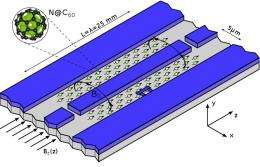September 9, 2009 feature
Proposed Quantum Computer Consists of Billions of Electron Spins

(PhysOrg.com) -- While researchers have already demonstrated the building blocks for few-bit quantum computers, scaling these systems up to large quantum computers remains a challenge. One of the biggest problems is developing physical systems that can reliably store thousands of qubits, and enabling bits and pairs to be addressed individually for gate operations.
With this issue in mind, scientists have recently proposed a quantum computing scheme that uses an ensemble of about 100 billion electron spins. They show that hundreds of physical qubits can be made from these collective electron spin excitations. The researchers, Janus Wesenberg from the University of Oxford, and coauthors from Oxford, Yale University and the University of Aarhus in Denmark, have published the proposed system in a recent issue of Physical Review Letters.
The system can also perform qubit encoding and provide one- and two-bit gates for quantum computing. In the setup, the electron spins are coupled to a superconducting transmission line cavity. In turn, this cavity is coupled to a transmon Cooper pair box that carries out the gate operations.
“A single electron spin only interacts very weakly with its environment: this makes it a good quantum memory, except that it is very hard to initialize or read out,” Wesenberg explained to PhysOrg.com. “In the ensemble register we make use of the fact that the collective interaction between an ensemble of billions of spins and a microwave cavity is greatly enhanced by the so-called superradiant effect. This makes it possible to transfer a microwave photon (carrying a qubit), from the cavity to the spin ensemble in a few tens of nanoseconds compared to a significant fraction of a second for a single spin. Once the photon has been transferred to the ensemble, it lives as an delocalized excitation.
“The state of the system is a quantum superposition of each spin being excited, that is, flipped relative to the very strong magnetic field that has been applied to the system. There is an infinite number of ways in which a single excitation can be superpositioned in this way, and these can be described in terms of spin waves. By applying a magnetic gradient pulse, we can transfer an excitation that lives as one kind of spin wave to another kind of spin wave.”
As Wesenberg added, the study brings up two independent new ideas.
“Firstly, there is the idea to couple an ensemble of electron spins to a stripline resonator,” he said. “While this is a novel idea, it is a straightforward extension of previous work (by Peter Zoller and many others), on coupling ensembles of polar molecules, Rydberg atoms etc. to such stripline cavities. The main advantage of using electron spins is that they can simply be smeared onto the stripline substrate without any need for complex trapping arrangements. Secondly, there is the idea of using the holographic principle to address a large number of modes in the ensemble by means of a controllable magnetic gradient. This is a relatively straightforward extension of work by one of the authors (K. Mølmer), on holographic storage.”
As the scientists explain in their study, one of the advantages of this setup is that a large number of spins can be controlled without requiring single spin measurement. Depending on the materials used, the system could achieve spin coherence times of up to tens of milliseconds, which could be used to build a solid-state device.
“The immediate plan is to demonstrate experimentally that this works,” Wesenberg said. “First in the semi-classical setting (which is essentially electron spin resonance spectroscopy), and later in the quantum regime. Experiments to this end are underway at Yale and Oxford.”
More information: J.H. Wesenberg, et al. “Quantum Computing with an Electron Spin Ensemble.” Physical Review Letters 103, 070502 (2009). DOI: 10.1103/PhysRevLett.103.070502
Copyright 2009 PhysOrg.com.
All rights reserved. This material may not be published, broadcast, rewritten or redistributed in whole or part without the express written permission of PhysOrg.com.

















